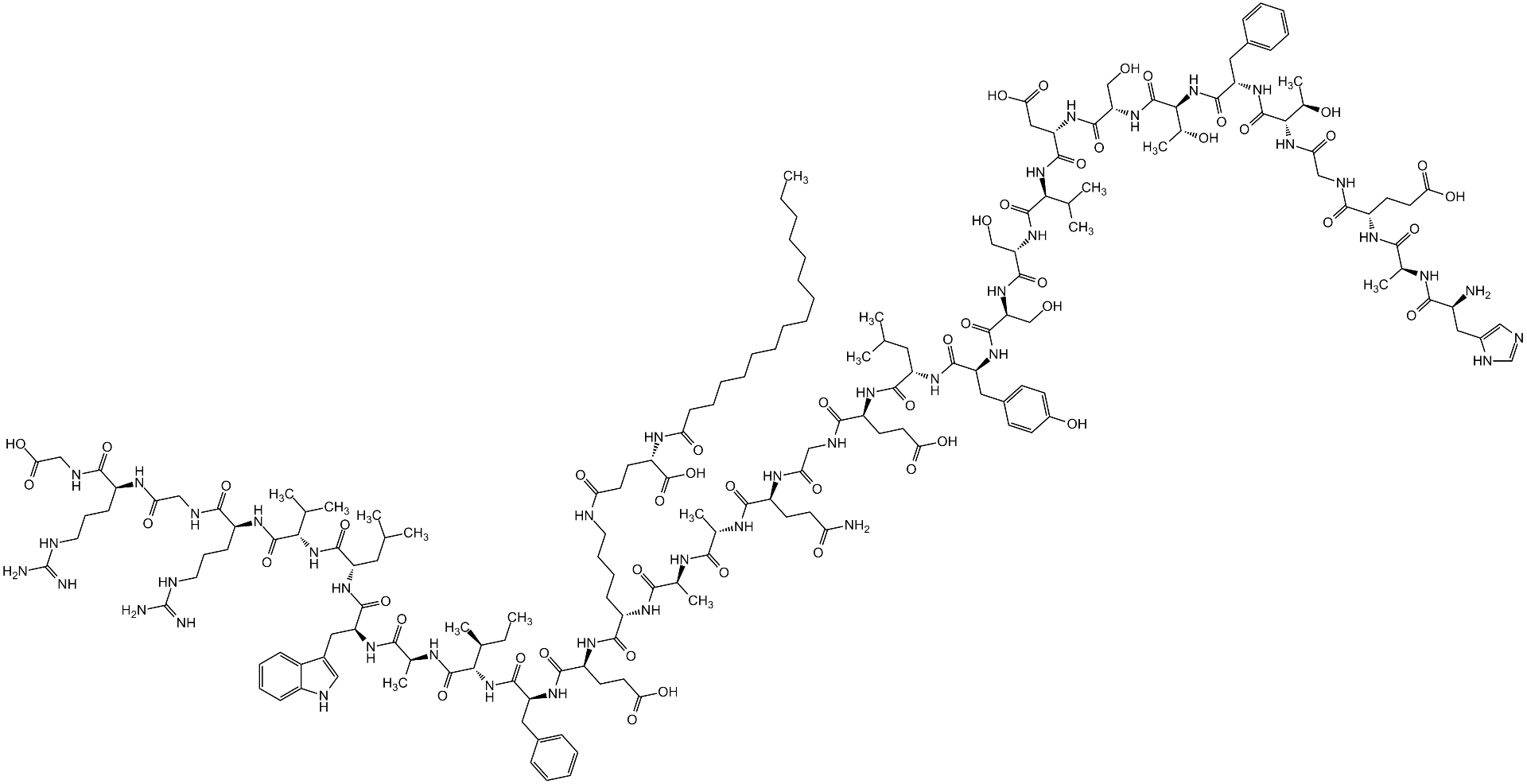
Chemical Structure
Liraglutide [204656-20-2]

AG-CP3-0034
Overview
- SupplierAdipoGen Life Sciences
- Product NameLiraglutide [204656-20-2]
- Delivery Days Customer10
- CAS Number204656-20-2
- CertificationResearch Use Only
- Estimated Purity>98%
- Molecular FormulaC172H265N43O51
- Molecular Weight3751.2
- Scientific DescriptionChemical. CAS: 204656-20-2. Formula: C172H265N43O51. MW: 3751.2. Synthetic. Long-acting acylated glucagon-like peptide-1 (GLP-1) receptor agonist. Antidiabetic and antiobesity agent used clinically to treat type 2 diabetes mellitus. Binding to GLP-1R, activates AMP-activated protein kinase, consequently stimulates insulin secretion in pancreatic beta cells and suppresses glucagon secretion in a glucose-dependent manner. Improves control of blood glucose and consequently modulates appetite and body weight. Inhibits beta cell apoptosis and improves beta cell mass. Shown to ameliorate glycometabolism and insulin resistance through the upregulation of GLUT4. Neuroprotective. Prevents neurodegenerative processes in pathologies such as Alzheimers and Parkinsons Disease. Anti-inflammatory agent. Exerts cardioprotective roles via activating prosurvival pathways and suppressing inflammation. Anti-pyroptotic by inhibiting TNF-alpha and hypoxia-induced inflammasome activation. Anticancer agent. Inhibited proliferation and induced apoptosis in cancer cell lines. Shown to inhibit osteoclastogenesis. - Long-acting acylated glucagon-like peptide-1 (GLP-1) receptor agonist. Antidiabetic and antiobesity agent used clinically to treat type 2 diabetes mellitus. Binding to GLP-1R, activates AMP-activated protein kinase, consequently stimulates insulin secretion in pancreatic beta cells and suppresses glucagon secretion in a glucose-dependent manner. Improves control of blood glucose and consequently modulates appetite and body weight. Inhibits beta cell apoptosis and improves beta cell mass. Shown to ameliorate glycometabolism and insulin resistance through the upregulation of GLUT4. Neuroprotective. Prevents neurodegenerative processes in pathologies such as Alzheimers and Parkinsons Disease. Anti-inflammatory agent. Exerts cardioprotective roles via activating prosurvival pathways and suppressing inflammation. Anti-pyroptotic by inhibiting TNF-alpha and hypoxia-induced inflammasome activation. Anticancer agent. Inhibited proliferation and induced apoptosis in cancer cell lines. Shown to inhibit osteoclastogenesis.
- SMILESO=C([C@H](CC(C)C)N([H])C([C@H](CC1=CN([H])C2=CC=CC=C12)N([H])C([C@H](C)N([H])C([C@H]([C@@H](C)CC)N([H])C([C@H](CC3=CC=CC=C3)N([H])C([C@H](CCC(O)=O)N([H])C([C@H](CCCCN([H])C(CC[C@@H](C(O)=O)N([H])C(CCCCCCCCCCCCCCC)=O)=O)N([H])C([C@H](C)N([H])C([C@H](C)N([H])C([C@H](CCC(N([H])[H])=O)N([H])C(CN([H])C([C@H](CCC(O)=O)N([H])C([C@H](CC(C)C)N([H])C([C@H](CC(C=C4)=CC=C4O)N([H])C([C@H](CO)N([H])C([C@H](CO)N([H])C([C@H](C(C)C)N([H])C([C@H](CC(O)=O)N([H])C([C@H](CO)N([H])C([C@H]([C@@H](C)O)N([H])C([C@H](CC5=CC=CC=C5)N([H])C([C@H]([C@@H](C)O)N([H])C(CN([H])C([C@H](CCC(O)=O)N([H])C([C@H](C)N([H])C([C@H](CC6=CN=CN6[H])N([H])[H])=O)=O)=O)=O)=O)=O)=O)=O)=O)=O)=O)=O)=O)=O)=O)=O)=O)=O)=O)=O)=O)=O)=O)=O)=O)N([H])[C@H](C(N([H])[C@H](C(N([H])CC(N([H])[C@H](C(N([H])CC(O)=O)=O)CCCN([H])/C(N([H])[H])=N/[H])=O)=O)CCCN([H])/C(N([H])[H])=N/[H])=O)C(C)C
- Storage Instruction-20°C,2°C to 8°C
- UNSPSC12352200
References
- The pharmacokinetics, pharmacodynamics, safety and tolerability of NN2211, a new long-acting GLP-1 derivative, in healthy men: H. Agerso, et al.; Diabetologia 45, 195 (2002)
- The long-acting GLP-1 derivative NN2211 ameliorates glycemia and increases beta-cell mass in diabetic mice: B. Rolin, et al.; Am. J. Physiol. Endocrinol. Metab. 283, E745 (2002)
- The long-acting glucagon-like peptide-1 analogue, liraglutide, inhibits beta-cell apoptosis in vitro: S. Bregenholt, et al.; BBRC 330, 577 (2005)
- Pharmacokinetics and pharmacodynamics of liraglutide, a long-acting, potent glucagon-like peptide-1 analog: J. Meece; Pharmacotherapy 29, 33S (2009) (Review)
- The diabetes drug liraglutide prevents degenerative processes in a mouse model of Alzheimer's disease: P.L. McClean, et al.; J. Neurosci. 31, 6587 (2011)
- Potential role of glucagon-like peptide-1 (GLP-1) in neuroprotection: C. Hoelscher; CNS Drugs 26, 871 (2012) (Review)
- Liraglutide ameliorates glycometabolism and insulin resistance through the upregulation of GLUT4 in diabetic KKAy mice: L.N. Chen, et al.; Int. J. Mol. Med. 32, 892 (2013)
- Liraglutide can reverse memory impairment, synaptic loss and reduce plaque load in aged APP/PS1 mice, a model of Alzheimer's disease: P.L. McClean & C. Hoelscher; Neuropharmacol. 76, 57 (2014)
- Glucagon-like peptide-1 (GLP-1) analog liraglutide inhibits endothelial cell inflammation through a calcium and AMPK dependent mechanism: N.M. Krasner, et al.; PLoS One 9, e97554 (2014)
- Liraglutide acutely suppresses glucagon, lipolysis and ketogenesis in type 1 diabetes: M. Garg, et al.; Diabetes Obes. Metab. 19, 1306 (2017)
